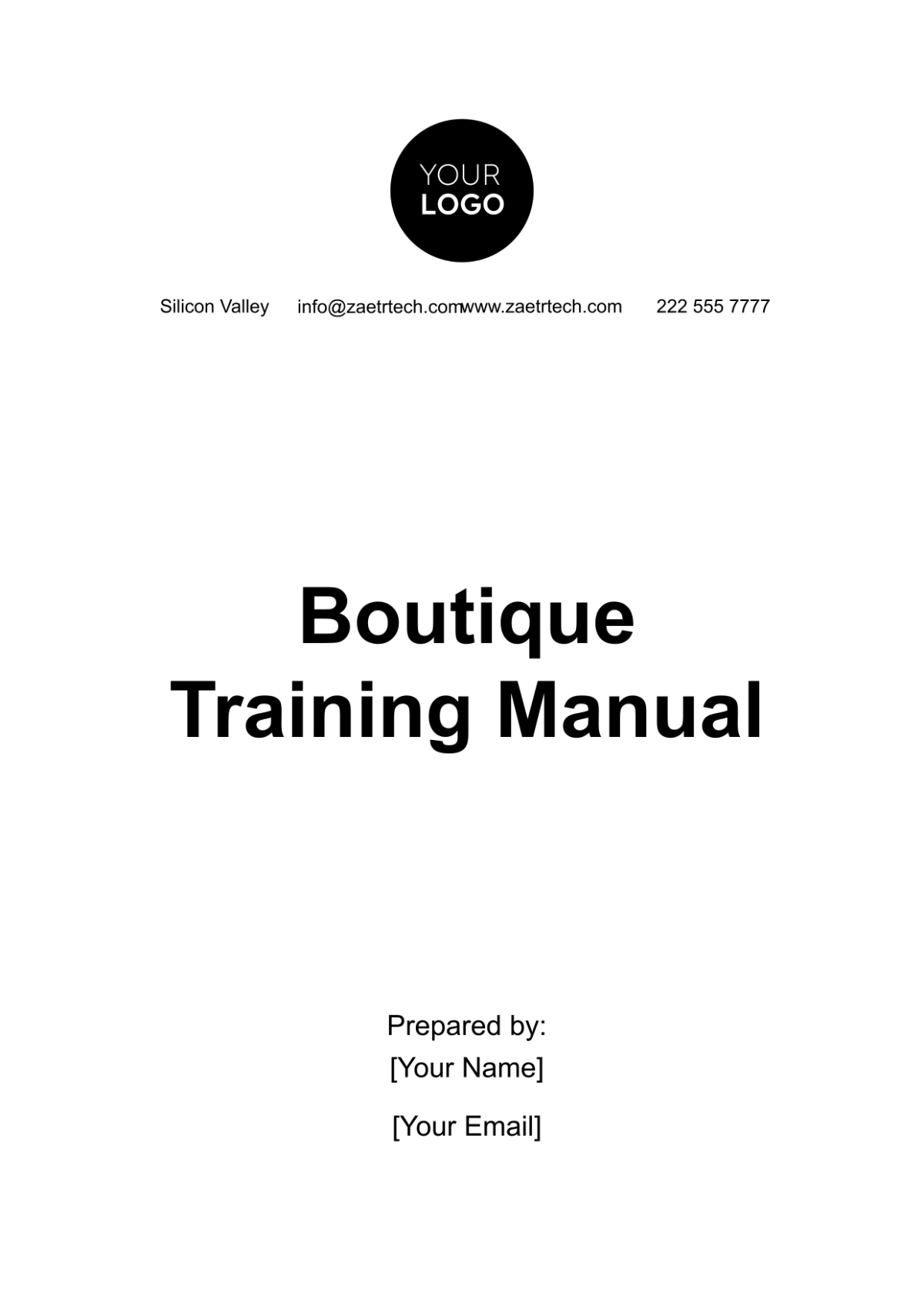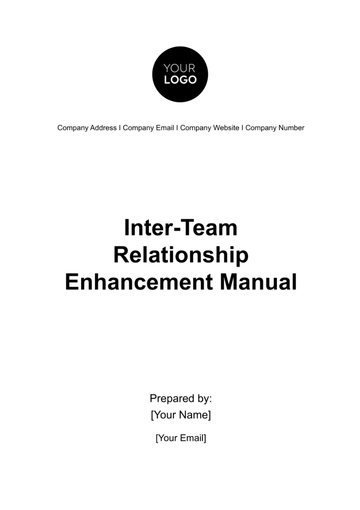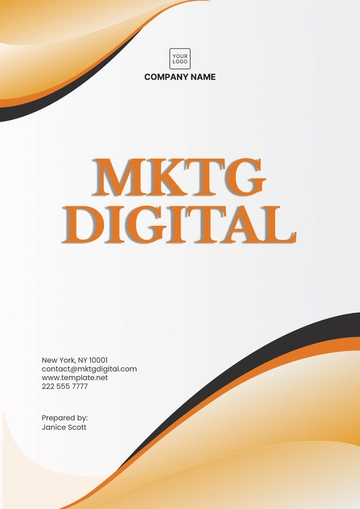Free Boutique Training Manual

I. Introduction
A. Purpose of the Manual
The Boutique Training Manual serves as a comprehensive resource for employees at [Your Company Name], providing clear guidelines, best practices, and systematic approaches to ensure consistency and quality in all operational aspects. This manual is designed to equip employees with the skills necessary to deliver superior customer service, manage boutique operations efficiently, and uphold the company’s high standards of luxury and personalized service. By adhering to the principles outlined in this manual, employees will not only contribute to a positive working environment but also foster long-lasting relationships with our valued customers. The manual will also serve as a vital training tool for onboarding new hires, facilitating cross-training opportunities for existing staff, and maintaining a continuous standard of excellence across all roles and responsibilities within the boutique.
II. Overview of [Your Company Name]
A. History and Background
Established in the early 21st century, [Your Company Name] has evolved into a prominent leader in the boutique services industry. From its humble beginnings as a single flagship location, the company has grown exponentially, expanding its presence to multiple boutiques across various global markets while maintaining its signature focus on providing exclusive, high-quality products and delivering personalized services. The journey of [Your Company Name] is marked by a commitment to innovation, customer-centricity, and excellence in every aspect of its operations. As we advance into the year [2050] and beyond, [Your Company Name] continues to lead the industry by embracing emerging technologies and adapting to evolving customer trends, all while remaining true to its luxurious brand identity.
B. Mission and Vision
Our mission at [Your Company Name] is to create an unparalleled shopping experience that seamlessly blends luxury with personalization. We strive to provide our customers with not just products, but a memorable journey that reflects their individual tastes and preferences. Our vision is to be recognized as the foremost boutique brand in the world by continually exceeding customer expectations, leveraging cutting-edge technology, and cultivating a team of highly trained professionals. Every interaction in our boutiques is designed to leave a lasting impression, ensuring that each customer feels valued and catered to in a way that is distinctively [Your Company Name].
III. Employee Roles and Responsibilities
A. Boutique Manager
1. Role Overview
The Boutique Manager plays a critical role in overseeing the entire boutique operation, ensuring that all employees meet company standards, and that the customer experience is consistently exemplary. This position is not only about managing day-to-day activities but also about inspiring and leading the team towards achieving the boutique's goals. The manager serves as a vital link between corporate offices and boutique staff, advocating for both employee needs and corporate directives.
2. Key Responsibilities
Staff Management
The Boutique Manager is responsible for hiring, training, and supervising all employees. This includes defining clear job roles and expectations, developing training programs tailored to individual learning styles, and fostering an environment of continuous improvement.
Ensuring that all staff adhere to the standards of [Your Company Name] in terms of appearance, punctuality, and performance is paramount. The manager must monitor staff behavior and provide constructive feedback to promote professional growth.
Conduct regular team meetings to review performance metrics, provide updates on company initiatives, and address any concerns or suggestions from team members. This open line of communication helps build trust and camaraderie among staff.
Implement performance improvement plans when necessary, and provide continuous coaching. Recognizing achievements and addressing weaknesses promptly will lead to a motivated and high-performing team.
Customer Service Excellence
Ensure that all customers receive the highest level of service, regardless of their backgrounds or shopping habits. This requires setting a clear standard of excellence that all staff members understand and commit to.
Handle escalated customer service issues efficiently and to the customer's satisfaction. This may involve direct interaction with the customer to understand their concerns and offering tailored solutions to address their needs.
Continuously monitor customer feedback and implement changes to improve service. Utilize customer satisfaction surveys and feedback forms to gather insights and make data-driven decisions that enhance the overall shopping experience.
Inventory Management
Maintain optimal inventory levels by coordinating with the warehouse team to restock high-demand items. This includes analyzing sales data to predict trends and prepare for seasonal fluctuations.
Conduct monthly inventory audits to ensure no loss or damage. A thorough understanding of the inventory management system will enable the Boutique Manager to track and manage stock levels effectively.
Develop promotional strategies for items that require sales boosts. Collaborate with the marketing team to create targeted campaigns that drive traffic and increase sales of underperforming products.
Financial Accountability
Responsible for managing the boutique's budget, ensuring profitability while minimizing operational costs. This involves monitoring expenses closely and identifying areas for cost savings without compromising service quality.
Conduct daily cash reconciliations and provide financial reports to corporate headquarters. Transparency in financial reporting fosters accountability and aids in strategic decision-making.
Track key performance indicators (KPIs), such as daily sales figures, average transaction value, and customer retention. Analyzing these metrics will provide insights into the boutique's performance and highlight areas for improvement.
B. Sales Associate
1. Role Overview
Sales Associates are the frontline representatives of [Your Company Name]. They are responsible for creating an inviting atmosphere, assisting customers in finding products that meet their needs, and facilitating a smooth and efficient checkout process. Their role is vital in fostering customer relationships and driving sales.
2. Key Responsibilities
Customer Engagement
Greet each customer with warmth and enthusiasm as they enter the boutique. A genuine welcome helps set a positive tone for the shopping experience.
Use advanced sales techniques, including active listening, product knowledge, and upselling, to drive sales. This means being attentive to customer cues and suggesting additional items that complement their selections.
Provide tailored recommendations based on customer preferences and past purchase history. By utilizing the CRM system, Sales Associates can offer personalized service that enhances customer satisfaction.
Product Expertise
Stay informed about the latest product releases, including materials, features, and benefits. Ongoing product training is essential to ensure staff can effectively communicate product value to customers.
Attend regular product training sessions to ensure knowledge is current. This knowledge enables Sales Associates to answer customer inquiries confidently and provide informed recommendations.
Demonstrate products to customers, highlighting key features and benefits to match their preferences. Engaging customers in product demonstrations fosters a deeper connection and can enhance the likelihood of a purchase.
Checkout Process
Ensure that all transactions are processed efficiently using [Your Company Name]'s cutting-edge POS system. This involves familiarizing oneself with the system's functionalities to minimize errors and expedite the checkout experience.
Handle returns, exchanges, and refunds in compliance with company policies. Transparency and clarity in the process will help maintain customer trust.
Encourage customers to enroll in the loyalty program for future benefits and exclusive offers. Highlighting the advantages of the program can incentivize sign-ups and foster customer loyalty.
C. Visual Merchandiser
1. Role Overview
Visual Merchandisers are responsible for the physical presentation of the boutique. Their creative vision plays a key role in attracting customers and encouraging sales through strategic display design and layout. This position involves a keen eye for detail and an understanding of current trends.
2. Key Responsibilities
Store Layout and Aesthetic
Work closely with the Boutique Manager to design floor layouts that maximize product visibility and flow. Understanding customer traffic patterns can inform decisions on product placement.
Change displays regularly to reflect seasonal trends, promotional events, or product launches. Keeping displays fresh and aligned with current marketing strategies is crucial for maintaining customer interest.
Maintain the cleanliness and organization of all visual displays. Regularly assess the condition of displays and products to ensure they are appealing and well-stocked.
Display Design
Utilize creativity and brand knowledge to create engaging and aesthetically pleasing product arrangements. This may involve experimenting with colors, textures, and layouts that resonate with the target customer demographic.
Ensure that displays are aligned with [Your Company Name]'s branding guidelines and color schemes. Consistency in branding reinforces brand identity and enhances customer recognition.
Marketing Coordination
Collaborate with the marketing team to implement promotional strategies in the boutique. This includes preparing visual content for marketing campaigns and in-store promotions.
Incorporate digital marketing tools, such as interactive displays, to enhance customer engagement. Utilizing technology in merchandising can create immersive experiences that draw customers in.
IV. Standard Operating Procedures (SOPs)
A. Opening Procedures
Unlocking the Boutique
Arrive at least [30] minutes before the store opens to complete essential opening tasks. This early arrival allows time to prepare and ensures that the boutique is ready for customers by opening time.
Use the security key to deactivate the alarm system and unlock the entrance. Familiarity with security protocols is crucial for maintaining safety within the boutique.
Opening Checklist
Conduct a thorough walk-through of the boutique to ensure that it is clean, well-organized, and that displays are set up correctly. This initial assessment allows staff to identify and address any potential issues before customers arrive.
Turn on all electronic systems, including the POS system, digital signage, and lighting. Ensuring that all technology is operational before opening is key to providing a seamless customer experience.
Review the day’s promotional events or key tasks during the staff huddle. A well-structured morning meeting helps keep all employees informed and aligned with daily objectives.
Stock Check
Verify that all essential items, such as shopping bags, tissue paper, and receipts, are adequately stocked. This preparation prevents interruptions during the customer experience.
Perform a quick visual check of key inventory items to ensure they are in their designated locations. This process helps staff identify items that may need restocking throughout the day.
B. Customer Service Protocols
Greeting and First Impressions
Every customer should be greeted within [10] seconds of entering the boutique. This prompt greeting is vital in establishing a welcoming atmosphere.
Associates should maintain open body language and make eye contact to create an immediate connection. Positive non-verbal communication reinforces verbal greetings and encourages engagement.
Active Listening
Listen carefully to each customer's needs without interrupting. Demonstrating patience and attentiveness is crucial for understanding the customer’s requirements fully.
Ask clarifying questions to ensure full understanding of the customer's preferences, such as, "What style or color are you looking for?" or "Is this a gift for a special occasion?" This tailored approach showcases genuine interest in meeting the customer's needs.
Handling Difficult Customers
Maintain a calm and professional demeanor, even when dealing with difficult customers. Emotional control in challenging situations reflects well on [Your Company Name] and can help de-escalate tensions.
Attempt to resolve any issues by offering alternatives, such as different products or discounts. Providing options empowers customers and may lead to a positive resolution.
If a situation escalates, involve the Boutique Manager to ensure it is handled appropriately. Having a clear protocol for escalating issues prevents confusion and maintains a high level of service.
Checkout and Farewell
Ensure that the checkout process is quick and seamless, reviewing items with the customer before finalizing the transaction. This attention to detail reinforces accuracy and helps avoid errors.
Offer to gift wrap or package the items if applicable. Providing additional services adds value to the customer experience and enhances overall satisfaction.
Always thank the customer and invite them to return, emphasizing any upcoming events or new product launches. This invitation reinforces a positive relationship and encourages repeat business.
C. Inventory Management
Receiving Inventory
Upon receiving new stock, count and verify the quantity against the delivery manifest. Accuracy during this process is crucial for maintaining inventory integrity.
Report any discrepancies to the Boutique Manager and arrange for prompt resolution. Timely reporting prevents issues from compounding and affects overall inventory accuracy.
Stock Rotation
Implement a stock rotation system to ensure that older products are displayed first, reducing the risk of unsold inventory. This practice minimizes waste and maximizes sales opportunities.
Mark down items that have been in stock for longer than [6] months. Implementing markdowns creates a sense of urgency for customers and can help clear out stale inventory.
Monthly Inventory Audits
Perform a detailed audit at the end of each month to account for all items in stock. Comprehensive audits allow for identification of loss prevention opportunities and inventory discrepancies.
Report any discrepancies, such as missing or damaged items, to corporate headquarters. Accurate reporting ensures that corporate management is aware of inventory challenges and can provide support as needed.
Use advanced tracking systems to monitor inventory levels in real-time, minimizing the risk of shrinkage. Technology can play a crucial role in preventing loss and improving overall inventory management efficiency.
V. Customer Experience
A. Personalization
Customer Profiles
Use the boutique's CRM (Customer Relationship Management) system to maintain detailed profiles for each customer. This database should include information about preferences, past purchases, and special occasions.
Offer personalized recommendations based on a customer’s buying history. For instance, if a customer frequently purchases luxury skincare products, staff should highlight new arrivals in that category.
Tailored Services
Offer personalized shopping experiences, such as private appointments where customers can browse new collections before they are available to the general public. This exclusivity adds value and elevates the customer's experience.
Introduce value-added services, such as personalized monogramming or bespoke gift wrapping, to enhance the customer experience. Tailoring services to individual customer preferences creates a memorable experience and fosters brand loyalty.
B. Loyalty Programs
Enrollment Process
Encourage customers to enroll in the [Your Company Name] loyalty program at checkout. Providing a brief overview of the program’s benefits can entice sign-ups.
Explain the benefits of the program, including early access to sales, special birthday discounts, and exclusive member events. Highlighting these advantages enhances perceived value.
Customer Engagement
Use data from the loyalty program to engage customers through targeted marketing campaigns. Personalized emails, exclusive offers, and birthday greetings can significantly enhance customer retention.
Ensure that loyalty program members receive special recognition during their in-store visits, such as personalized thank-you notes or exclusive discounts. Creating a sense of exclusivity for members fosters loyalty and repeat business.
VI. Health and Safety Protocols
A. General Safety Measures
Store Cleanliness
Ensure that all surfaces, including counters, displays, and fitting rooms, are sanitized regularly throughout the day. Establishing a cleaning schedule can help maintain high hygiene standards.
Maintain hand sanitizing stations at the entrance and near checkout points. Signage encouraging hand sanitization can promote customer participation.
Emergency Procedures
Familiarize all staff with the location of emergency exits, fire extinguishers, and first aid kits. Conduct regular drills to reinforce procedures and ensure preparedness.
Conduct regular fire drills and safety briefings to ensure preparedness in case of an emergency. Understanding evacuation routes and procedures is vital for staff and customer safety.
Health Monitoring
All employees are required to undergo regular health checks, particularly during peak seasons when customer volume is high. Monitoring employee health minimizes the risk of spreading illness.
If an employee feels unwell, they must report their condition immediately and take appropriate leave. Cultivating a culture of health awareness is essential for maintaining a safe working environment.
B. Cybersecurity and Data Protection
Protecting Customer Data
All customer information collected, including payment details and contact information, must be stored securely in compliance with data protection laws. Regularly review data handling practices to ensure compliance with regulations.
Ensure that the POS system is regularly updated with the latest security patches. Implementing strong cybersecurity measures is essential for protecting sensitive customer data.
Employee Training
Provide training on cybersecurity best practices, including how to recognize phishing scams, secure login protocols, and the importance of using strong passwords. Continuous training ensures that employees remain vigilant against potential threats.
VII. Continuous Improvement and Training
A. Ongoing Education
Training Programs
Develop ongoing training programs to keep staff updated on new products, sales techniques, and customer service strategies. Regular training sessions foster a culture of learning and improvement.
Offer workshops on personal development, such as communication skills, emotional intelligence, and conflict resolution. Investing in employee growth enhances job satisfaction and performance.
Performance Feedback
Implement a structured feedback system that allows employees to receive constructive feedback from managers and peers. Regular feedback helps employees understand their strengths and areas for improvement.
Encourage self-assessment and peer evaluations as part of the performance review process. Self-reflection can lead to personal growth and improved performance.
B. Customer Feedback Mechanisms
Gathering Customer Insights
Create opportunities for customers to provide feedback through surveys, suggestion boxes, or direct communication with staff. Understanding customer perceptions is key to improving the shopping experience.
Regularly review feedback and implement actionable changes based on customer suggestions. Communicating back to customers about changes made as a result of their feedback fosters loyalty.
Implementing Changes
Encourage staff to participate in discussions about customer feedback and potential improvements. Collective input can lead to innovative solutions that enhance the boutique experience.
Track the effectiveness of implemented changes through ongoing customer surveys and sales metrics. Measuring the impact of adjustments helps refine future strategies.
- 100% Customizable, free editor
- Access 1 Million+ Templates, photo’s & graphics
- Download or share as a template
- Click and replace photos, graphics, text, backgrounds
- Resize, crop, AI write & more
- Access advanced editor
Train your staff effectively with the Boutique Training Manual Template from Template.net. This editable and customizable template provides essential training materials and guidelines. Personalize it using our Ai Editor Tool to ensure high standards in service. Empower your team—create a thorough training manual now!





























